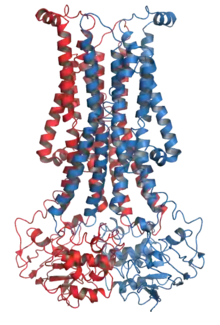Flippase
Flippases (rarely spelled flipases) are transmembrane lipid transporter proteins located in the membrane which belong to ABC transporter or P4-type ATPase families. They are responsible for aiding the movement of phospholipid molecules between the two leaflets that compose a cell's membrane (transverse diffusion, also known as a "flip-flop" transition). This is necessary to continue their normal function of growth and mobility.[2] The possibility of active maintenance of an asymmetric distribution of molecules in the phospholipid bilayer was predicted in the early 1970s by Mark Bretscher.[3][4] Although phospholipids diffuse rapidly in the plane of the membrane, their polar head groups cannot pass easily through the hydrophobic center of the bilayer, limiting their diffusion in this dimension. Some flippases - often instead called scramblases[1] - are energy-independent and bidirectional, causing reversible equilibration of phospholipid between the two sides of the membrane, whereas others are energy-dependent and unidirectional, using energy from ATP hydrolysis to pump the phospholipid in a preferred direction.[5] Flippases are described as transporters that move lipids from the exoplasmic to the cytosolic face, while floppases transport in the reverse direction.[1]

Many cells maintain asymmetric distributions of phospholipids between their cytoplasmic and exoplasmic membrane leaflets.[6] The loss of asymmetry, in particular the appearance of the anionic phospholipid phosphatidylserine on the exoplasmic face, can serve as an early indicator of apoptosis[7] and as a signal for efferocytosis.[8]
See also
References
- Hankins, Hannah M.; Baldridge, Ryan D.; Xu, Peng; Graham, Todd R. (January 2015). "Role of Flippases, Scramblases and Transfer Proteins in Phosphatidylserine Subcellular Distribution". Traffic. 16 (1): 35–47. doi:10.1111/tra.12233. PMC 4275391. PMID 25284293.
- Nagata, Shigekazu; Sakuragi, Takaharu; Segawa, Katsumori (2020-02-01). "Flippase and scramblase for phosphatidylserine exposure". Current Opinion in Immunology. Innate immunity. 62: 31–38. doi:10.1016/j.coi.2019.11.009. ISSN 0952-7915.
- Bretscher, Mark S. (1 March 1972). "Asymmetrical Lipid Bilayer Structure for Biological Membranes". Nature New Biology. 236 (61): 11–12. doi:10.1038/newbio236011a0. PMID 4502419.
- Bretscher, Mark (1974). "Some Aspects of Membrane Structure". In Estrada-O., Sergio; Gitler, Carlos (eds.). Perspectives in membrane biology first Mexican Society of Biochemistry symposium. New York: Academic Press. pp. 3–24. ISBN 9780323143592.
- Holthuis, Joost CM; Levine, T.P. (2005). "Lipid traffic: floppy drives and a superhighway". Nature Reviews Molecular Cell Biology. 6 (3): 209–220. doi:10.1038/nrm1591. hdl:1874/7842. PMID 15738987. S2CID 11439631.
- Lodish, H, Berk A, Matsudaira P, Kaiser CA, Krieger M, Scott MP, Zipursky SL, Darnell J. (2004). Molecular Cell Biology, 5th, New York: WH Freeman.
- Castegna, A; Lauderback, CM; Mohmmad-Abdul, H; Butterfield, DA (2004). "Modulation of phospholipid asymmetry in synaptosomal membranes by the lipid peroxidation products, 4-hydroxynonenal and acrolein: implications for Alzheimer's disease". Brain Res. 1004 (1–2): 193–7. doi:10.1016/j.brainres.2004.01.036. PMID 15033435. S2CID 17234790.
- Nagata, Shigekazu; Segawa, Katsumori (February 2021). "Sensing and clearance of apoptotic cells". Current Opinion in Immunology. 68: 1–8. doi:10.1016/j.coi.2020.07.007. PMID 32853880. S2CID 221360052.